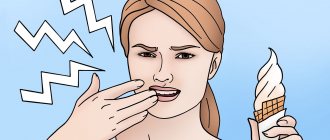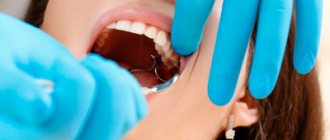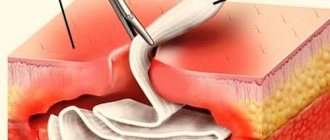28.10.2019
Tooth extraction is an operation, no matter how simple and common it may be, but it is a surgical intervention. Consequently, despite its relative simplicity, it is fraught with the risk of complications, which, fortunately, are much less common than successful outcomes.
After tooth extraction, antibiotics are very often prescribed. Is it correct? Let's find out in this article.
Features of tooth extraction in children
Pediatric dentistry is focused on the treatment and prevention of oral diseases. In this case, psychological support for the baby is important. Specialists must act delicately, instilling trust and relieving the child of fears. This is especially important in case of forced tooth extraction. Therefore, there are several unspoken rules of the pediatric dentist.
- Do not use the word “pain” or the particle “not.” Children do not accept denial and react sharply to unpleasant phrases.
- Do not discuss the details of the procedure in the office. Medical terms and unfamiliar words frighten the baby.
- Try to hide dental instruments from the eyes of the small patient. Forceps, packages of syringes and drill attachments can drive even the most courageous tomboy into hysterics.
This procedure requires high professionalism and great care from the doctor. With one careless movement, he can damage the germ of a new tooth and the tissue of the socket, which will cause a delay in eruption and various dentofacial deviations.
Is it possible to do x-rays?
It is not advisable for pregnant women to undergo X-rays, and it is strictly contraindicated in the first trimester. But at a later date, if there is evidence, such a procedure is possible. Fortunately, modern dentistry uses equipment with highly sensitive sensors and minimal radiation. During the examination, the patient’s chest and abdomen are covered with a lead apron.
Attention!
To avoid the risk of complications in the fetus, it is worth taking care of prevention at the stage of pregnancy planning. Before deciding to expand the family, a woman needs to consult a dentist, cure all carious lesions, chronic diseases of the gums and periodontal tissues, and, if necessary, undergo procedures to strengthen tooth enamel. Those who are preparing to become a mother need to pay special attention to hygiene and proper oral care, because during pregnancy the risk of developing caries increases.
General indications for tooth extraction in children
The child’s dentition is formed according to certain patterns: the incisors erupt first, followed by the molars. Then the baby teeth are gradually replaced by permanent teeth. If this process occurs correctly, without deviations from the norm, there is no need to specifically remove baby teeth. However, there are situations when this is necessary:
- advanced caries;
- the last stage of development of a cyst on the gum;
- severe tooth injury;
- a tooth that fails to develop and erupt.
Removing a child’s front tooth is a particularly unpleasant procedure, as the aesthetics of the smile suffers. Usually, surgery is resorted to in the following circumstances:
- exposure of the pulp due to a fracture of the coronal part;
- severe tooth decay with the impossibility of prosthetics;
- inflammatory diseases that cannot be treated.
Most often, children have to part with their teeth in the chewing area. Molars are more susceptible to destruction than premolars and incisors. Removing a child's molars, which are the last in the dentition, is complicated by their inaccessibility and strength: they fit quite tightly to the gums, have wide roots and massive walls.
Sometimes children develop an anomaly such as an extra tooth, which can move the “neighbors” and lead to curvature of the entire row. If it does not interfere with the normal formation of the remaining teeth, you can leave it and try to integrate it into the bite, but most often they resort to removing the supernumerary tooth in the child.
The factors described above are the general and most common indications. Let us consider separately the reasons for the removal of baby and permanent teeth.
How does the timing of tooth extraction affect pregnancy?
In case of severe inflammation and pain, it is not always possible to postpone surgical intervention. If there are indications for extraction of a dental unit, then the possibility of carrying out the procedure must be agreed with the therapist and gynecologist. In this case, the period of bearing the child is important. Each trimester has certain restrictions and possible complications for the mother and fetus.
Possibility of extirpation according to timing:
- First trimester. The placenta is being formed, the organs and systems of the child are being formed, so any medical manipulations are performed with extreme caution and only according to strict indications. During this period, most drugs are contraindicated, and surgery without them is impossible. Medicines, x-rays, and computed tomography have a negative effect on the fetus, causing various abnormalities. Some medications cause miscarriage. Even treatment of deep caries can be postponed to a later date. However, there are situations that do not allow you to avoid removing a diseased tooth. If there is severe pain and inflammation, this leads to hypertonicity of the uterus, nervous breakdowns, spread of infection to other organs, and infection of the fetus. In this case, the dentist can perform the operation despite contraindications.
- Second trimester. After 3 months, the fetus is formed and the placenta is well protected. During this period, many types of treatment are allowed, including extraction, except for complex cases with a figure eight. Mother's stress and medications do not have such a strong effect on the child and pregnancy. Local anesthetics can be used safely. Before a CT scan or X-ray, a woman puts on a special protective apron.
- Third trimester. Surgical intervention is highly undesirable. Although the fetus has become physically stronger, by this time the placenta is thinning and protects it less well. In addition, the period is dangerous for premature birth. Stress and pain can cause uterine contractions. Starting from the thirty-fourth week, almost any treatment is stopped.
At any time, extraction is carried out for purulent inflammation, which cannot be cured by therapeutic methods. In addition, if a pregnant woman suffers severe pain and is constantly under stress, this can have a bad effect on the child’s psyche.
Removal of baby teeth in children
Milk teeth maintain the gum contour and ensure proper development of the jaw and chewing muscles. Therefore, it is important to wait until they fall out on their own. Unfortunately, this does not always happen, and the dentist is forced to prescribe surgery if there are the following indications for the removal of baby teeth in children:
- the tooth is loose, but has not fallen out for a long time;
- the temporary tooth caused inflammation of the oral tissues;
- The permanent tooth has begun to emerge;
- a fistula has formed on the gum;
- a cyst appeared on the root;
- The tooth has decayed due to caries.
Removal of a child's front milk tooth may be associated with fractures, chips and other injuries, as well as inflammatory processes.
Is it possible to remove teeth in position?
Since many medications are prohibited during pregnancy, expectant mothers refuse to have their teeth treated or removed and endure pain until childbirth. But in many cases such a measure is not justified. It is possible and necessary to carry out treatment or extirpation, the main thing is to do it correctly.
Anesthesia is done using local drugs that have minimal side effects and do not have a negative effect on the fetus. However, the operation is performed only if there is an urgent need.
Indications for extraction:
- pulpitis, periodontitis, in which neighboring tissues become infected;
- deep carious lesion affecting the root;
- cyst or malignant neoplasms;
- growth of a figure eight, complicated by inflammation or if it presses on an adjacent molar;
- tooth root fracture;
- rapid development of periodontal disease, which is not amenable to therapeutic treatment.
If a pregnant woman experiences pain when chewing, she will not be able to eat properly, which leads to a deficiency of nutrients. This situation negatively affects her body, the formation and growth of the fetus.
The doctor considers each case individually. If possible, reschedule the operation for a more convenient time.
Removal of permanent teeth
Removal of a permanent tooth in a child is carried out only in the following situations:
- Caries.
If the doctor sees that a decayed tooth cannot be treated, most likely he will suggest removing it. - Fracture.
A tooth fragment can injure the mucous membrane; it can either be restored or removed. - Crowding.
When installing braces or plates, it is sometimes necessary to remove one tooth to allow others to develop freely. - Complications after treatment.
Sometimes, after poor-quality dental procedures, problems arise that can only be solved by getting rid of the tooth.
Wisdom tooth removal
Typically, wisdom teeth appear at the age of 20 or older, but in some cases it is recommended to remove their buds. There are the following reasons for the removal of wisdom teeth in children:
- displacement of the follicle of the third molar;
- prerequisites for malocclusion;
- lack of space for wisdom teeth.
A specialist can recommend removal of a child’s wisdom teeth only after a thorough examination and consultation with other specialized doctors. You must first determine what position the molar is in and what place it will later occupy in the jaw.
Anesthesia for tooth extraction
In modern clinics, various types of anesthesia are used to remove teeth for children without pain. The specialist selects the appropriate drug in accordance with the severity of the clinical picture. During the operation, one of the following methods of pain relief is used:
- Sedation is putting you into a sleepy state to reduce anxiety.
- Application anesthesia - treatment of the gums with an anesthetic solution to remove a loose tooth or before injection.
- Local anesthesia is the administration of an anesthetic through an injection.
- Anesthesia is used in difficult cases and when removing teeth for a child under 2 years old.
Care after tooth extraction
What frightens the parents more than the removal procedure is the condition of the baby after the operation, since they have already left the specialist’s office and are left with the problem alone. In this situation, all mothers and fathers have almost the same questions.
What to do after a child’s tooth extraction?
The doctor will give the little patient a cotton pad or gauze pad that needs to be placed in the empty hole to stop the bleeding. Removing a baby tooth does not cause excessive blood flow, so after half an hour you can safely remove the cotton wool, but removing a permanent tooth is accompanied by severe bleeding.
The appearance of a blood clot means that the healing process is going well, as it protects the bone from air and prevents inflammation.
What medications should I take?
If the dentist prescribes an antibiotic after a child’s tooth extraction, follow the recommendations and do not give the child other medications so as not to provoke complications.
How to rinse your child's mouth after tooth extraction?
For three days after surgery, rinsing your mouth is strictly prohibited, so as not to dislodge the blood clot and cause an infection. Three days after tooth extraction, the child can rinse the mouth using any means - strengthening tinctures of tree bark, soothing herbal decoctions or medicinal solutions.
How much can you eat after a child’s tooth extraction?
For the first few days, you should refrain from hot dishes and fermented milk products, eating only soft and liquid foods. It is best to chew on the side opposite the extracted tooth.
How to choose
In most cases, the doctor prescribes a specific medication, depending on its functionality. There are several selection criteria:
- patient's condition;
- his age category;
- financial condition;
- indications.
There is currently no shortage of medicines. The best manufacturers offer both proven complexes and new products. The dentist will tell you which company is better, based on the rating of quality products. The best products are not budget ones. As a rule, a person is given a list of medications to choose from, both inexpensive and at a significant price.
Which product is best to buy depends on the patient’s preferences and capabilities. Many people, before making a purchase, review the possible options, determine what drugs in this area generally exist, carefully study the characteristics, contraindications, and reviews.
What should you pay attention to so as not to make mistakes when choosing? According to buyers, the average price and reputation of the manufacturer are not always important. The main thing is the ability of medications to achieve the desired result and the presence of individual intolerance. To take precautions, choose the right antibacterial purchase option. Give preference to public or private pharmacies with a proven range.
If, when asked where to buy the required complex, you chose an online store and want to order it online to save money, then you need to remember the disadvantages of this method of purchase. Often, this is how you can purchase a low-quality product (counterfeit), which can cost a person’s health or even life.
Complications after surgery
Do not give in to panic and call the ambulance service at the slightest ailment of the baby. Some consequences of tooth extraction do not harm children's health in any way. The following symptoms are considered normal:
- The child’s gums ache after tooth extraction - apply ice, this will reduce the discomfort.
- After tooth extraction, the child has swelling - after the third day it will begin to subside; ice also helps eliminate the discomfort.
- A swollen cheek after tooth extraction in a child indicates a slight inflammatory process, which will go away on its own after some time.
- Light bleeding in a child after tooth extraction should also not cause concern; even the next day the saliva may be slightly reddish.
- A low temperature after tooth extraction in a child is the result of the child’s worries and nervous overstrain; when he calms down, the temperature will drop.
How is the affected tooth removed?
The procedure itself should only be performed by an experienced surgeon and only when other treatment methods can no longer help. There are a number of reasons that can trigger the removal of an affected tooth:
- if the crown of the tooth is completely destroyed;
- when the patient is indicated for prosthetics;
- if complications arise during the eruption of a wisdom tooth;
- if filling requires perforation of the root canal.
Important ! There are cases when there is every reason to remove a tooth, but the patient has contraindications to this. In such cases, most often the intervention is carried out within the walls of a hospital with subsequent monitoring of the patient’s condition.
There are a number of main contraindications to surgical tooth extraction. These include:
- previous heart attacks;
- high blood pressure;
- arrhythmia;
- blood diseases;
- mental problems or neurological diseases.
If no contraindications have been identified in a patient who needs surgical removal of the affected tooth, then he is referred to the procedure itself, which should be carried out according to the following scheme.
| Stage | Description |
| Visit doctor | Before performing the procedure, the doctor must find out whether the patient has allergic reactions to any anesthetics, cardiovascular pathologies, or whether the patient suffers from hypertension. |
| Anesthesia | After all the necessary information has been obtained, the patient is sent for anesthesia. A fairly large number of different means are currently used to remove teeth. Their duration of action is from forty minutes to three hours. |
| Preparation | Next comes preparation for the intervention itself: in order not to injure the gum during manipulation, it first peels off from the tooth bone by at least five millimeters. This procedure is carried out using a special tool. The surgeon places special forceps on the tooth, and then begins to swing the tooth itself with them in order to destroy the ligaments attached to the jaw bone. |
| Removal | The affected tooth itself is pulled out, that is, extraction. After the affected tooth has been removed, the resulting hole must be thoroughly examined. This is necessary so as not to leave tooth fragments or a cyst in the wound cavity. If the extraction of the affected tooth took place in the presence of flux, then after its removal the gums are cut in the right place and the pus is released. After this manipulation, a drainage is inserted into the wound cavity. |
| Treatment | After the procedure is completed, you need to treat the wound itself. If pus is found at the site of the lesion, then in this case the hole must be washed with an antiseptic solution, and then an anti-inflammatory agent should be placed in the wound. If the hole itself is too large after extracting the tooth, then a suture is necessary. |
| Consultation | After the procedure has been completely completed, before discharge, the doctor must instruct the patient in detail on how to care for the hole during the healing period, and also prescribe any medications if necessary. |
After the tooth is removed and before the patient goes home, the doctor inserts a special medicine into the tooth socket. It is necessary to protect the wound from various influences, as well as for faster and more proper healing. Some patients complain that the turunda with the medicine interferes greatly, but this will have to be endured.
Important ! If you remove the turunda ahead of time, serious complications may develop, which will have to be dealt with not only by the dentist, but also by other doctors.
The doctor prescribes exactly the medicine that is safe for every person. True, it does not have the most pleasant taste, but a person will have to ignore this factor if he wants the wound to heal as quickly as possible.
There are exceptional cases when it is simply impossible to remove the affected tooth according to the scheme above. The reason for this may be the following factors:
- if the tooth root is crooked;
- if the bone tissue of the tooth is too fragile;
- if the crown of the affected tooth is already completely destroyed;
- if the figure eight is in a position of incomplete eruption or in a horizontal position.
If a patient who needs tooth extraction has any of these characteristics, then the intervention is performed in a different way. First, the gum is cut and peeled away from the bone. After this, the specialist drills out the desired area using a drill, which creates access to the root of the required tooth.
Important ! In some cases, the partitions between the roots of the tooth are sawed, after which each root is removed one by one.
After such procedures, healing is more difficult and longer. Such an intervention may cause the patient to develop stomatitis. In many cases of such intervention, a secondary infection is attached to the affected area.
However, no matter which tooth is removed, medicine must be placed in the hole. This procedure is required.
Flux, fever and diarrhea after tooth extraction
More serious negative consequences when removing a baby tooth in children can only arise as a result of poor quality work by the doctor or due to infection. If the following signs are detected, parents must immediately contact a specialist.
- Flux after tooth extraction in a child, preventing swallowing, breathing and muscle movement.
- Prolonged bleeding.
- Severe and prolonged pain in the gums that does not go away even after taking painkillers.
- After tooth extraction, the child’s temperature rose above 38 degrees.
- Abdominal pain, vomiting and diarrhea after tooth extraction in a child.
Anesthesia, painkillers and antibiotics
Anesthetics during pregnancy are dangerous because they can penetrate the placenta and also increase blood pressure due to the high content of adrenaline. However, its concentration in a ratio of 1:200,000 has been proven to be safe for both mother and child. It is recommended to use ultracaine and ubistezin as pain-relieving injections during pregnancy. And it is better not to use lidocaine, which is more popular in dentistry, as a “freeze”: it causes cramps and muscle weakness. Also, during pregnancy, anesthesia is strictly prohibited. If complex treatment or tooth extraction cannot be avoided, the doctor may prescribe painkillers to the patient. Ibuprofen and paracetamol are considered the safest during pregnancy, but you need to keep in mind that taking ibuprofen is not recommended in the 3rd trimester. Antibiotics should also be avoided by expectant mothers, but if there is a risk of complications and the development of bacterial infections, drugs from the group of penicillins and cephalosporins are acceptable.
How much does tooth extraction cost?
Many people believe that the cost of the procedure for adults is much higher than for children, and the price for removing a baby tooth in children is lower than for extracting a permanent tooth. This is not entirely true. The amount of payment for the pediatric dentist depends on the complexity of the case, and the cost of removing temporary and permanent teeth is determined by the indications and concomitant diseases. In the table below, we have listed the main problems with which people turn to a pediatric dentist and the prices for tooth extraction for children.
| Service | Price |
Consultation | from 500 rubles |
Removing a baby tooth | from 1,100 rubles |
Removal of a permanent single-root tooth | from 1,200 rubles |
Removal of a permanent multi-rooted tooth | from 3,000 rubles |
Complex tooth extraction | from 4,000 rubles |
Wisdom tooth removal | from 3,000 rubles |
Removal of a supernumerary tooth | from 1,200 rubles |
Application anesthesia | from 250 rubles |
Local anesthesia | from 500 rubles |
Sedation | from 1,500 rubles |
General anesthesia for 30 minutes | from 4,000 rubles |
General anesthesia for 60 minutes | from 10,000 rubles |
General anesthesia for more than an hour | from 12,000 rubles |
How to prepare a child for tooth extraction
If tooth extraction is unavoidable, try your best to minimize the child’s stress. For example, tell him a fairy tale about how one tooth began to behave badly and interfere with the others, so it needs to be “pulled out.” Before going to the clinic, you can also discuss some pleasant event with your child, be it going to the movies, the circus, or buying a toy, which you will do immediately after removing a capricious tooth. The main thing is not to panic, and then the confident and calm attitude of the parents will certainly give the child the strength to courageously endure this frightening but necessary procedure.
You can avoid tooth extraction surgery in children if you carefully monitor the condition of the oral cavity throughout the entire period of dentition formation, monitor the quality of hygienic procedures and regularly take children to preventive appointments with the dentist.
About the medicine
The medicine that is placed in the hole can be applied to a piece of gauze, which is subsequently inserted into the hole. In this case, after a certain amount of time indicated by the doctor, it needs to be taken out. This can be done either independently or during your next visit to the dentist. If this is not done in time, the process of putrefaction may begin, which will greatly complicate the situation. It is also not recommended to take out the gauze ahead of time, since food particles can get into the hole and the tongue can touch it, which will interrupt the healing process and also cause complications.
There is another way to install the medicine - in a hemostatic sponge. It already contains a medicine that helps disinfect the socket cavity and helps stop bleeding. You cannot take this sponge out - it will dissolve on its own. Most often this happens within 1-2 days, but in some cases the sponge may remain in the hole for 5-6 days. There is no need to be afraid of this. As a last resort, you can consult a doctor who will examine the wound and determine whether healing is proceeding normally.
Often the medicine in the sponge is very bitter, and this causes severe discomfort to the person. Unfortunately, nothing can be done about this, since getting rid of the sponge ahead of time is strictly contraindicated. To eliminate bitterness, you can drink sweet tea or juice.
Remember ! No circumstances can influence the ability to remove the medicine from the hole ahead of time. After 3-4 days, the surface of the hole will heal, and you will no longer have to experience discomfort.
People often wonder what kind of medicine is used for these purposes. Sometimes the gauze that is placed in the hole is treated with iodine - this will both disinfect the wound and prevent bleeding. The hemostatic sponge is already treated with a special substance consisting of boric acid, collagen and nitrofural, which helps stop the bleeding and protect the hole from various influences. But most often dentists use Alvozhil.
No other means are used for inserting into the hole.











